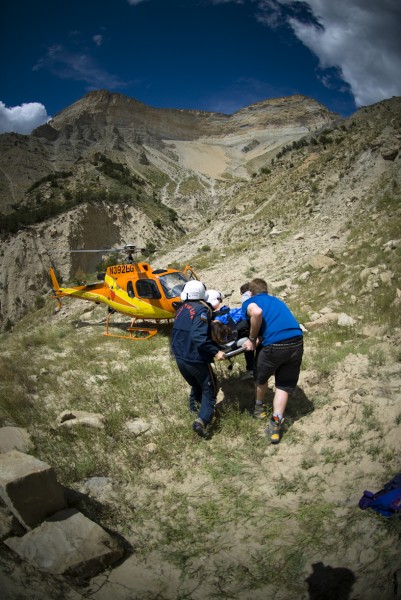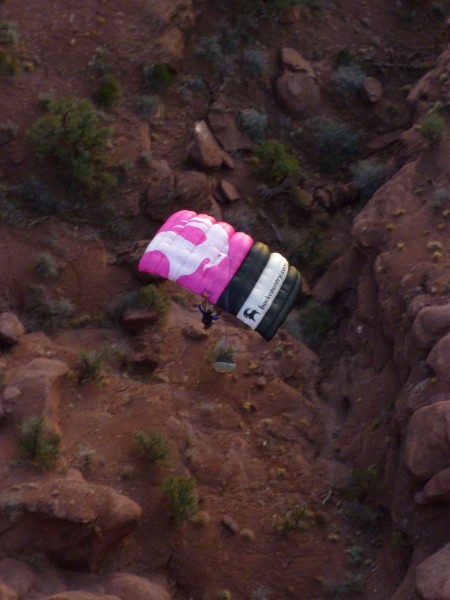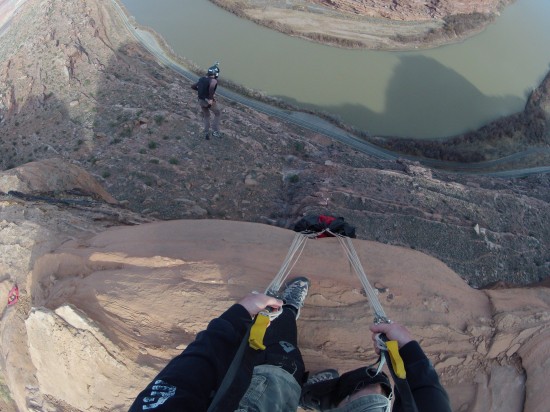Coming Back After Injury
Hi Steph,
Your adventures, stories, and life have been a great motivation for my wife and I. The reason I’m emailing you is because a recent fall that has me questioning all the risks we take. I was climbing in jtree and took a 30ft ground fall. I received 7 staples to the back of my head and a fractured C7. As I’m laying here in bed I can’t help but wonder if I’m ever going to be able to get back on the sharp end and is it worth it. We climb for the experience of the outdoors and passion to prove ourselves and see how we react when faced with adversity. But to be honest with you, this really sucks… Have you or your friends ever experienced this? And how did they find the grrrr to get back on the sharp end?
Thanks,
Bryan
Hi Bryan,
I hope you are recovering well, and I’m sorry to hear about your accident. Personally, I have never gotten hurt climbing, but I have had some injuries that took time to heal. In my first year of base jumping, I didn’t have the experience to stay safe, and also didn’t have the experience to hold myself back while I gained skill gradually. I got hurt twice in that year with a fracture in the front of my pelvis and then 3 fractures in my sacrum and torn rib intercostals. As a climber and especially as a professional climber, being injured at all, even with a sprained toe, feels like a very big deal because even the smallest injury stops you from climbing.

I learned a lot from those accidents and I developed a very different approach to base jumping and a pretty uncompromising theory of skill versus risk. I think it is better not to jump at all (whether in one situation or across the board) than to do it with inadequate skill or in any type of less-than-ideal circumstances. Those were the big lessons I learned, as well as more technical things about wind, equipment and decision making. Unrelated, I had ACL surgery a year after those two accidents, and that was a very long recovery time. So those are my big injury experiences.
It was very hard for me to start jumping again after ACL surgery, and this is the part that may have some relevance to you. My ACL was partially torn for over a year, unbeknownst to me after I slipped on snow with a backpack on and just assumed I had sprained my knee. I finished the tear a year later during a very routine, uneventful base landing. The landing was not the cause of my ACL tear, it just finished off the already torn tendon that was basically hanging by a thread, but my brain could not let go of the idea that a perfectly soft, normal landing could suddenly cause my ACL to sever. It took me over two years to really believe in my left knee after having the surgery. I was very paranoid about it, and always protecting it when landing. Base jumping in Moab can set you up for hard landings, because you are always jumping in no wind, and it’s at higher altitude. I didn’t even try to land on my feet for a year after my knee recovered, because I was so nervous of re-injuring it. I slid in on my hip every time I jumped, lifting up my legs to keep them from getting any kind of impact, which is obviously not so good for your hips and other joints or your pants or self esteem. It’s really hard to let go of that protective instinct that gets lodged deep in your brain when you’ve been injured. It’s kind of humiliating to land on your butt when you’ve done hundreds of skydives and hundreds of base jumps….but when the ground came up, my deep instinctive desire to protect my ACL at any cost was always stronger than ego.
I remember about a year ago having really bad landings nearly every day, while beginning jumpers were landing nearby on their feet. And I remembered being a beginning jumper and always landing on my feet before my ACL injury, and it was driving me nuts that I couldn’t seem to do the simplest thing. Though my overall canopy skills had become good, I lost all confidence in myself and I wasn’t having fun jumping because of it. It was becoming a mental problem and a self-perpetuating cycle. I thought about quitting jumping. I was frustrated and having a bad time, so I didn’t really see the point of doing it. But at the same time, I could see the situation for what it was–a mind fuck–and I decided to try to deal with the phase, be patient and get through it. I knew it really wasn’t possible to jump every day and never break out of that cycle, even though it seemed like it was going to last forever. I decided to just keep jumping, try not to be so hard on myself, and assume that things would eventually get better. And they did.

I’m still reluctant to do a crazy run when I’m coming to the ground, but I’ve also increased my skill set to finetune my landings well enough that I generally don’t have to run them out, and can land softly on my feet or take a couple of steps. My brain is gradually starting to believe that my ACL graft is stronger than a Kleenex. I make a point of doing lots of lunge steps when I lift weights and warrior poses every morning when I do yoga, and I know that strengthens my left leg, and is good for the other one too. As with everything, it takes a lot of time, persistence and patience with your recovery process–mental as much as physical.
The really important thing about having an accident in your sport is to learn from it. A lot of times things happen just through bad luck. But having a minor accident can actually be a good thing, a cheap lesson, if you analyze it and yourself objectively. Many times, as in my early base bangups, accidents happen as a result of a mistake you made and/or a lack of skill. It’s crucial to be really honest with yourself when evaluating your accident. Did you just get unlucky and happen to be in the wrong place at the wrong time? Or did you put yourself in a position you didn’t have the skill and experience to get yourself out of? Were you being reckless? Were you in over your head? What could you do differently in the future? Maybe your approach to climbing and to risk will be slightly different–I’m not saying you should limit or sabotage yourself with fear, but you may want to change the equation of your skill level versus the risk you take on.

You may also decide that climbing is not worth it to you. There are a lot of other things in life that are incredible and fulfilling, and you may decide that it’s time to experience them. Climbing is fantastic, but it’s not the only thing in life. It is definitely a time-consuming one. You don’t have to define yourself by any one thing–you as a climber is just one part of you as a whole person, and climbing may simply prove to be part of your evolution.
It will probably be really hard mentally to start leading again, if you choose to do so. Don’t push yourself too hard at first–if you push too hard, you will most likely get frustrated or get panicked and have a bigger mental setback. Just take it easy for a while and realize that even deciding to climb again is a big mental step. Just climb in whatever form you can. Eventually you will get to a point where you’ll feel that you’re being pushed back by a mental wall, and you may even have a mind fuck like me. 
A good friend of mine was dropped off the end of a rope while being lowered, and he smashed both of his heels. It was a life-altering accident, and he spent the last several years in recovery from the original accident and then more recovery from subsequent surgeries, and physically he will never be the same as before. He works out, swims, bikes and does yoga consistently and climbs almost every day, though he can’t run or do things that create impact on his heels. He doesn’t have feeling in parts of his toes and even his big toes, and he has to cut holes in the heels of his climbing shoes where they press on some of his injury points. He is an extremely careful climber, and though he likes to travel alone, he makes an effort to climb with people he knows. He likes working routes, but doesn’t love taking huge whippers. The main change he made after his accident is to always put a knot in the belayer’s end of the rope before he starts up a pitch–he does that himself, he doesn’t ask the belayer to do it, or assume they will keep an eye on the end, he does it himself. When working routes, he works around his injuries and figures out what he can do, rather than what he can’t do. He’s about to turn 50, and he just redpointed his hardest route, a 13d sport climb.
Wish you all the best,
Steph








Steph! You have the best way of putting things. Thanks!
Very relevant as my 13 yo just took a fall last Tuesday at climbing practice. Missed the dyno at the top of a 20′ wall and came off. 13 yo belayer’s hand was too close to the ATC, the fall jerked his hand into the ATC, he jumped up and dropped the rope. She free fell at least the last 10 feet. I came to pick her up right then, and we had to call 911, and I watched her get strapped to a backboard in a collar. 4 hours later she was cleared for fractures. She is healing, but not ready to go back just yet, and her belay partner says he never wants to climb again. The recovery will be a process. Just thankful they are both ok. And, the coaches now know that they need to change some of their procedures at practice. Thanks for sharing your story
Very scary I’m glad they are not hurt, and hope they are not too unsettled by the experience.
I’m glad they are not hurt, and hope they are not too unsettled by the experience.
Steph, thanks for this thoughtful post. I’m 2 months out of ACL surgery and this really strikes a chord:
Most likely, your progress will happen slowly over time, with patience. It will probably be so slow that it will seem like nothing is happening and you will get frustrated beyond belief at times.
It’s really helpful for us non-pro athletes to see that you can keep your passion for your sport as well as slowly regaining confidence.
Good luck with your recovery
Steph, thanks for this post. It is very timely for me. I have been climbing for nearly 15 years. I have had many overuse injuries which eventually respond to treatment. I developed an elbow injury about 4 months ago. I do not remember a specific incident, but a growing tendinitis which unfortunately, I continued to climbed with. Imaging has not shown anything significant. I am receiving ultrasound, acupuncture and massage. I do no eccentric exercises to encourage blood flushing and healing. The pain and stiffness recede, only to return again. One possible diagnosis is osteoarthritis. I have not climbed for more than a month and it is hard to not get down and fear I won’t climb again. My doctor has suggested a cortisone injection. Can you advise me at all on what you know about cortisone?
Thank you Steph and Bryan for this topic.
Bryan, I understand what it is like to come back from a traumatic injury. I broke and dislocated both of my ankles in a bouldering accident. While my initial recovery was remarkably quick, I still deal with the after effects everyday, 5 years later. I learned quite a few things from this experience.
First thing was, I wanted to get back on the rock as soon as possible. I did not want to be shrouded by fear. This was very important in my recovery. (Of course, I spent lots of hours at PT and at the gym staying strong, preparing for this day.)
At the doctor’s orders, once I was cleared to climb (12 weeks post injury), I began on top rope for several weeks. Then I slowly, and cautiously, got back into bouldering. I was definitely, and understandably, protective for quite some time. And then naturally, it just became easier and something that I thought about less and less.
Five years later, I have arthritis in the right ankle which can be challenging for me at times. I deal with varying levels pain on a regular basis. Some days are pain free, and some days it is excruciating. I had no idea how mentally tough I am.
But, I persist and I am kind to myself. I have had to forgive myself for my accident, and that has taken years. I have had to accept my part in it, my bad decisions. This has been more difficult for me than dealing with getting high off the ground again, or taking a fall.
This accident changed my climbing life forever. I have learned to assess risk better, I have learned to listen to my gut instincts and to trust myself, and I have learned to climb more deliberately, with greater precision, and with full commitment. Aside from the physical pain that I live with, I have taken away only positive things from this difficult experience, and I wish the same for you!
Was it worth it to get back out there? For me, 100% yes. It fills me up. Spending time alone climbing is my favorite thing to do. This is a time of connecting with myself, and building that relationship with myself.
I see climbing now from such a wider perspective than I did before my accident. What drives me to climb is different and more rich now than what drove me before. Climbing has become nearer and dearer to my heart, and less of an outward expression to others. It has become more personal and rich in beauty and creativity than it ever was before. There is less of my ego in it, and more of my soul. For that gift alone, I am grateful.
Sometimes I wish that it didn’t take such a harsh lesson to get right with myself, but in the end, I learned what I needed to. And I will climb, old and gray.
Best wishes to you Bryan, in all aspects of your recovery!
Brandy
Hi Eileen,
I don’t know much about cortisone: but I do know several climbers that have had the injections for elbow tendinitis. I know it helped them when they had the shots but I don’t know anything about longterm effects or results: that might be a good question to ask before having them.
Steph
Thanks Brandy!
Beautiful post Steph! Such wisdom. This point is especially relevant to me: “…if you push too hard, you will most likely get frustrated or get panicked and have a bigger mental setback.”
I’ve experienced this a lot and have finally learned to listen to myself and gauge my risk threshold for that particular day (without judgement). It’s hard when we thrive on pushing ourselves and our boundaries. It’s a fine line between pushing in a healthy way and overdoing it because we weren’t listening to our wiser, core voice.
Thanks for the reminder to be patient with injury and all the incredible wisdom in this post.
Thanks Amy!
Thank you for this post! Reading your books and following your adventures has always been such an inspiration for me in climbing. I recently took a 30ft ground fall in Red Rocks and came out with an L2 compression fracture-basically a broken back. I’ve been feeling a little lost on how to look forward to a complete recovery. That’s when I Googled “Steph davis injuries,” because I knew you would have insight. Sure enough this post appeared! I will be re-reading this post on rainy days, that’s for sure. You’re so right: my climbing is going to be different and that’s a good thing. Every day in my job as an outdoor educator we talk about risk management. Sometimes, I think we forget it also applies to our personal lives. Thank you for your thoughtful and honest posts. They help keep my stoke high for my climbing future!
I’m glad it could help, heal up quick